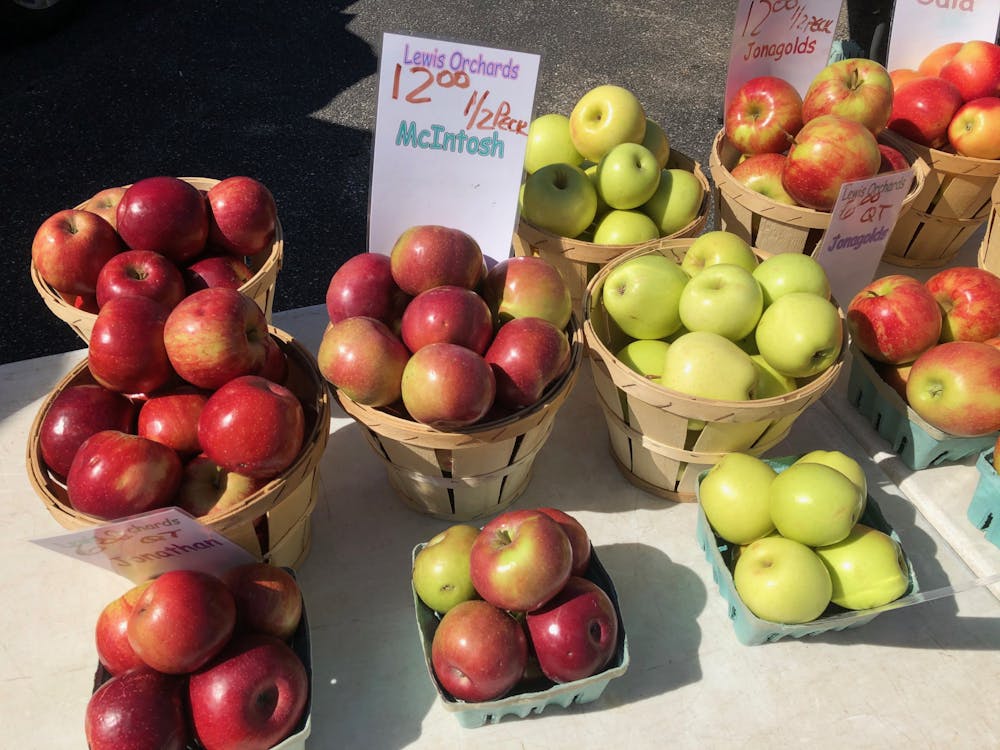It’s Saturday morning. You step outside your building hungover, 15 minutes late, organic tote bag in hand. You spy two figures waiting for you. One of them sports fading blue hair. Clearly, she’s not like other girls (newsflash: she is). The other figure wears a neck gaiter (okay Miss Rona) and oversized sunglasses. She could literally be anybody.
You begin to walk. Within mere seconds, you spy your ex across the street and make eye contact. You walk another block. You spot a Tinder match and avert your gaze. You walk two more blocks. Is that Dr. Anthony Fauci?
“We can go home now,” you tell your friends. “I’ve already been seen.”
Indeed, if you’re a Hopkins student in Baltimore, going to the 32nd Street Farmers Market in Waverly is the only way in this economy for people to know you’re alive. Amid the coronavirus (COVID-19) pandemic, it’s the closest thing to performing your existence on M-Level. It’s the safest means of replicating the social anxiety of a darty. And it’s the wholesome, year-round version of Spring Fair, sans golf carts and the Office of Student Leadership and Involvement.
Saturday between 7 a.m. and 12 p.m. (prime time is around 10 a.m.) is the perfect opportunity to take a break from posting infographics on your Instagram story. Yes, I know it’s hard to believe, but there’s another way to virtue signal. Show everyone you know in Charles Village that you love both supporting local businesses and venturing a good 0.4 miles beyond the Hopkins bubble.
“Is it taboo if instead of getting iced coffee here,” you’ll ask under your breath, “I order from Bird in Hand on my way out?” No one will hear you. When you get inevitably overwhelmed by the breadth of options — eggplants, raspberry pies, artisanal goat cheese, obtuse, rubber goose, green moose, guava juice — and whisper, “I think I’ll go to Trader Joe’s instead — fuck it, I’ll just Instacart,” still no one will hear you.
But everyone will see you — all dressed up in your Saturday best and ready to have a meet-cute with your soulmate and burn in the morning sun — and know that you’re the goddamn lifeblood of this community.
On a more serious note, the market, which is celebrating its 40th anniversary, offers Baltimoreans a valuable service. Its mission is to provide both “a vehicle for independent vendors to survive large agribusiness competition” and what would otherwise be inaccessible produce to “an underserved city community.”
About a quarter of Baltimoreans live in a food desert, or a low-income neighborhood with limited access to affordable and nutritious food. Food deserts lead to poor eating habits, which in turn lead to health issues.
Food deserts are in part the result of redlining and other racist policies during the 1930s. The Home Owners’ Loan Corporation deemed non-white neighborhoods risky for mortgage support, outlining them in red on residential security maps that were used for decades to deny loans to Black and brown people in major American cities.
To this day, redlined Baltimore neighborhoods like Waverly have lower rates of homeownership, worse health outcomes and higher rates of poverty and segregation. Grocers have been reluctant to open in low-income neighborhoods, instead choosing to follow affluent white people to more suburban areas. Food deserts reflect intentional disinvestment in communities of color.
To demonstrate these patterns, Lawrence Brown, an assistant professor in the School of Community Health and Policy at Morgan State University, coined the terms the “White L” and the “Black Butterfly.” Predominantly white neighborhoods, which form the shape of an “L,” have structural advantages over predominantly Black neighborhoods, which form the shape of a butterfly’s wings. The White L tends to have more supermarkets, whereas the Black Butterfly tends to have more convenience stores with few fresh or healthy food options.
Here in Baltimore and across the country, COVID-19 has exacerbated food insecurity and other racial inequities. The most economically vulnerable are facing unemployment and loss of income the hardest.
As a result, farmers markets — which supplement and maximize federal nutrition benefits — are playing an especially valuable role during the pandemic.
But because of supply chain problems and workplace infections, American food systems are disintegrating. Many farmers nationwide, already in economic crisis before COVID-19, have lost significant revenue due to declines in consumer spending and restrictions on restaurants and schools.
So, consider shopping at the Market if you can. Given that it’s outdoors and there’s fresh air, it may be safer than going inside a grocery store. Plus, it’s the only way to be perceived anymore.





